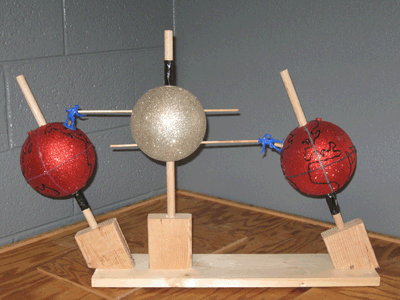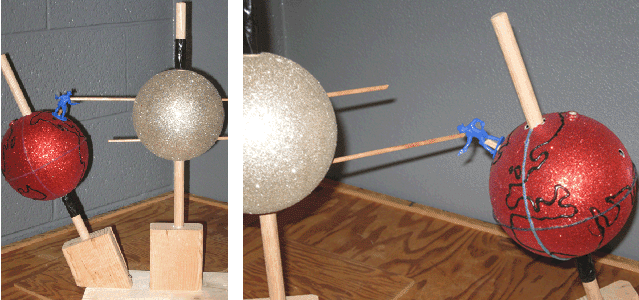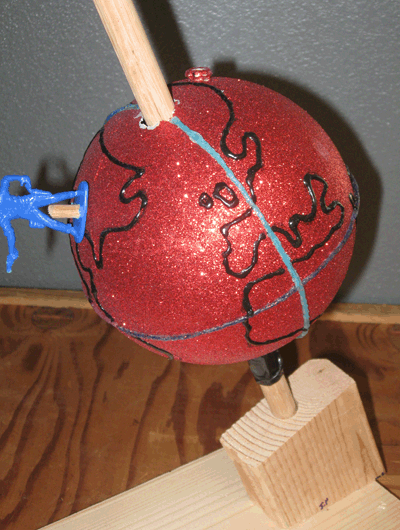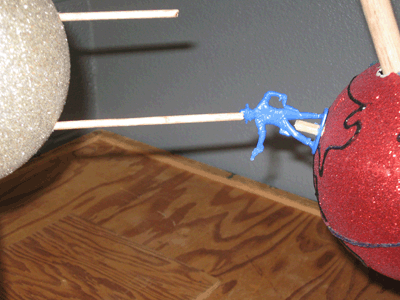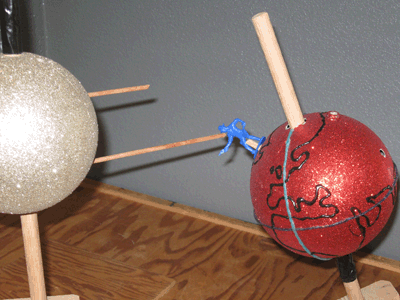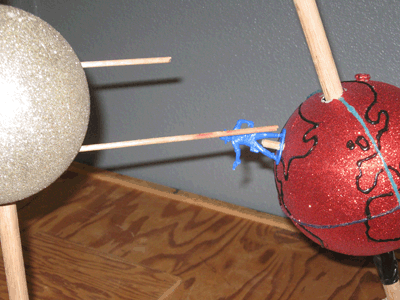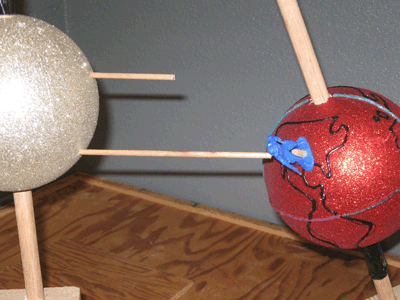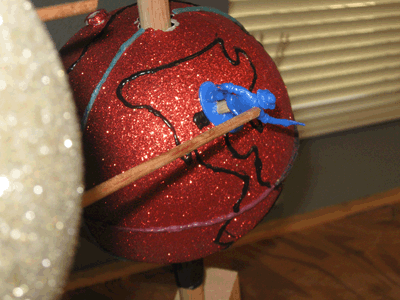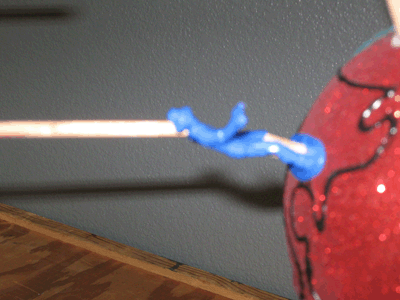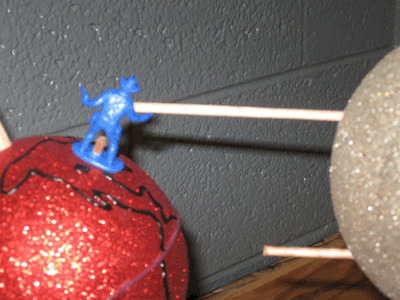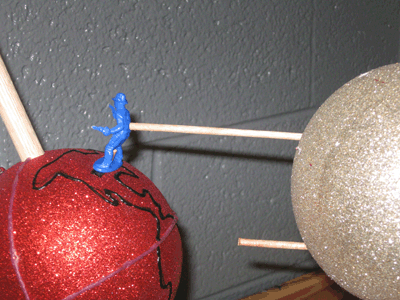|
Home | Programs | Contact | News & Events | For Parents | For Students | VI Resources | Photos |
||||||||||||||||||||||||||||||||||
|
|
||||||||||||||||||||||||||||||||||
|
Some concepts are challenging to explain verbally. Models, visual or tactual, can be extremely helpful when teaching how things work. The Winter/Summer Sun Position Model was developed to help students understand why the sun appears where it does in the sky in winter and summer. The Winter/Summer Sun Position Model is accessible visually and tactually. The two red balls represent the position of the Earth in summer and winter while the gold ball represents the sun. (The model is obviously not to scale as the sun and Earths in the model are all the same size and the figures used on the earth are the size of continents.) The smaller wood dowels inserted through the sun horizontally represent rays of light. A student can follow the path of a ray of light from the sun to a point on the Earth. The small blue plastic toy figures are extraordinarily large for the size of the two Earths but needed to be big enough for students to determine which cardinal direction the figure was facing. Note that the Earths and sun are held in place via wooden dowels. This allows the Earths to be turned to show what happens when the sun rises. As the rotation continues the student can see and feel how the orientation of the rays changes during the day and then what happens as the sun sets. The horizontal dowels in the sun that represent rays of light can be pushed/pulled to allow the ray to continue to reach the figure as the Earth rotates. The O&M applications are obvious; knowing that the sun rises in the east in the summer but the southeast in the winter (at most American and European latitudes) can help a visually impaired student establish orientation more accurately. This could be taught via rote but that teaches the basic fact without teaching the concept behind it. Science teachers may also find the Winter/Summer Sun Position Model useful. The concept of a day can be taught via the rotation of the Earth in relation to the rays of the sun. Because the Earths are simply resting in holes bored into the blocks of the base, one of the Earths can be removed from the base and revolved around the sun to show the position of the planet in the various seasons/months of the year. The Earths are set in bases which are cut to 22.5 degree angles, which is close to the 23 degree axis of the Earth. The winter Earth (northern hemisphere) is positioned closer to the sun than the summer Earth; a fact generally unknown but also often a state test question. While the sun only has rays emanating in one plane, the sun could easily and more accurately be modified to show that rays in fact shoot out from the sun in all directions. Social studies teachers may also find the model a handy way to explain the equator and prime meridian. Concepts like latitude and longitude can be taught as well. The seasons can be explained via the tilting of the Earth either towards or away from the sun.
Educators: Please feel free to construct and use this device at your discretion. However, NMSBVI assumes no liability regarding this innovation or its use/misuse.
For additional information, please contact the inventor, Ron Later, at
rlater@nmsbvi.k12.nm.us
The Winter/Summer Sun Position Model is very easy to construct. It was built with a piece of 1”x6” wood for the base. Three blocks of scrap 2”x4”s were screwed to the base. The two blocks that represent Earth were cut at a 22.5 degree angle while the block for the sun was not. The block for the sun was placed close enough to one of the two blocks for the Earth for students to be able to easily tell that the sun wasn’t exactly in the middle. Holes were then bored into the blocks to allow for the dowels that held the Earths and sun to rest in them. Holes were drilled into the balls to allow for the large dowels (to hold the Earths and suns on the base) and smaller holes were drilled in the sun for the smaller dowels that represent rays of light.
|
||||||||||||||||||||||||||||||||||
|
|
||||||||||||||||||||||||||||||||||
| Serving the Youth of New Mexico and Their Families since 1903 | ||||||||||||||||||||||||||||||||||
| Please read the
Terms
And Conditions Of Use
carefully before using this site. If you do not agree to these terms and conditions of use, please do not use this site. Comments to: webmaster@nmsbvi.k12.nm.us Last Updated: 4/12/2012 |

